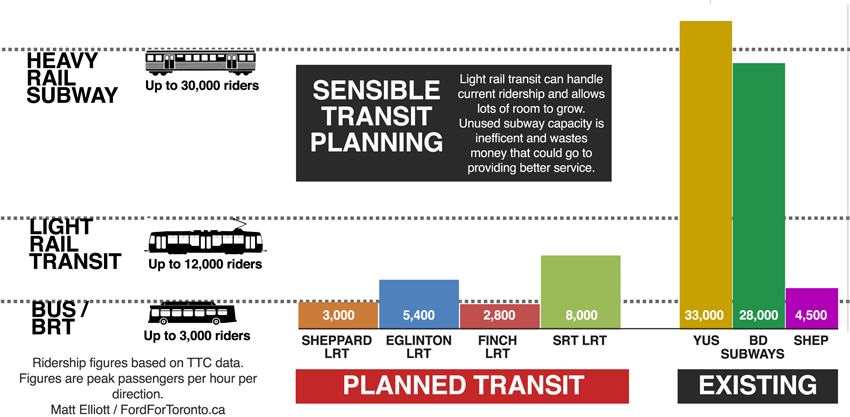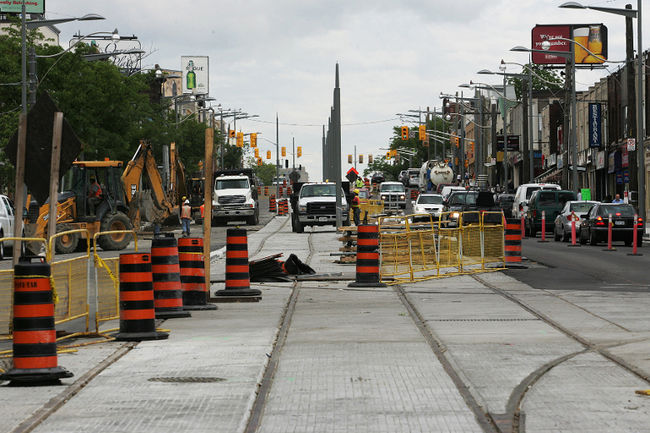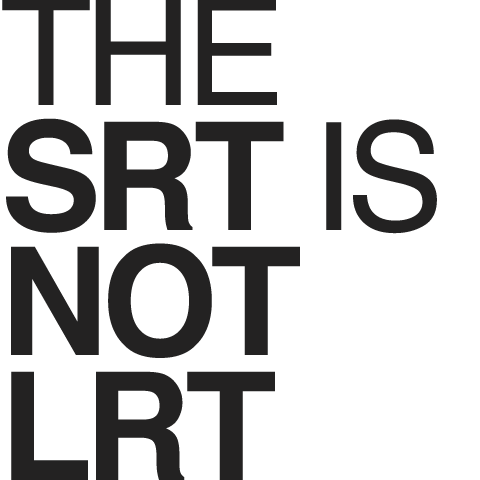
Building any of the proposed Transit City routes as heavy rail subway would mean significant unused capacity. Click for bigger.
On March 21, City Council will — I hope — finally end the transit debate that’s been overshadowing every other municipal issue this year. At that meeting, they’ll decide whether to endorse the previously-approved plan for light rail on Sheppard East or shift to a subway-based plan as per the mayor’s wishes.
While various town hall events have been described as either pro-subway or pro-LRT, my experience has been that a good percentage of the people attending these meetings are mostly just confused. They’re hearing conflicting things, sometimes from the same people. Opinions seem to shift from week-to-week. Mob mentalities run rampant and, weirdly, two very similar types of transit technology have become associated with the eternal left-wing versus right-wing pissing match.
So let’s simplify. Straightforward answers to straightforward questions.
Should we build an extension of the Sheppard Subway?
No. The ridership just doesn’t exist in that corridor to justify full-scale subway construction. The existing Sheppard Subway would need to be at least three times busier during peak periods to even begin to approach efficient use of infrastructure.
Planners and engineers don’t need to agonize too much when choosing transit technology: ridership projections make the choice obvious.
But Scarborough is growing, right? Shouldn’t we plan for the long-term? I heard this story about the viaduct…
You often hear politicians and historians trot out the Bloor Viaduct as an example of prudent long-term planning because it was built to support a future rail crossing, but that analogy doesn’t hold when we’re talking about subways. Making the viaduct subway-ready increased capital costs, but it had minimal impact on operation and maintenance.
It doesn’t make sense to take on all the increased costs associated with running a subway just in case riders show up in 50 or 100 years.
To truly justify full-scale subways, Scarborough residents would need to accept significant change to their neighbourhoods, because ridership follows density. Written mathematically, the equation would look like this: more people + more jobs = more subways.
And so Scarborough would need to densify and get busier. That means a significant shift. Single family homes would need to give way to multi-unit residences. Low-rises would need to become high-rises. Parking lots would need to vanish under new development. Scarborough would need to change.
Are residents really willing to accept that?
Aren’t LRTs slow and unreliable? I don’t want a second-class kind of transit.
Where modern cities are building transit, they’re mostly building LRTs. Subway construction has become so enormously expensive on a per-kilometre basis that large-scale building requires significant federal investment. If LRT is second-class, than dozens of major world cities are building vast networks of high-ridership second-class transit.
Light rail vehicles are more than capable of providing fast, reliable service. They run well in the snow and vehicles can be coupled together into trains. Many of the factors that slow down our downtown streetcars won’t exist on the light rail routes: riders will board from all doors, the vehicles will be low-floor to ease boarding for people with disabilities or those with strollers, and all routes will run in an exclusive right-of-way, meaning LRVs will move quickly even if traffic is backed up.
That said, service speed and reliability is primarily a function of TTC management and funding – not transit technology. The city has always invested to ensure frequent service on the subway – even where other cities have reduced subway service in the evenings and on weekends – Â which is why so many find it the most reliable way to travel.
Won’t LRTs tear up the road and cause businesses to fail? We don’t want another St. Clair disaster!
Here’s a picture of St. Clair Ave when it was under construction, via the Toronto Sun:
And here’s a shot of the Sheppard Subway, from when it was under construction, via VIVA Next:
You don’t get shiny new transit infrastructure without a period of pain-in-the-ass construction, unfortunately. Yes, subways are underground, but the stations need to come up to the surface which usually requires reconfiguration of utilities. No matter what you build, streets will need to be dug up, traffic will need to be diverted and everything will end up covering in a thick layer of dust and grime.
The only difference? Subway construction tends to take longer.
But Scarborough already has an LRT and it’s terrible! It breaks down constantly, offers a rough ride and already needs to be replaced!
A helpful infographic explaining the differences between the Scarborough RT and the proposed LRT lines the city is planning to build:
The Scarborough RT was the result of the provincial government deciding to use Scarborough residents as lab rats. They took an unproven technology – ICTS, a kind of proto-Skytrain – and forced it onto the TTC, in the hopes that everything would work out great and they could then sell the same technology to other cities for a tidy profit.
It didn’t work. The experiment was a failure. Today, Bombardier is the exclusive supplier of the vehicles used on the SRT. As a result, parts, maintenance and replacement vehicles come at a high price premium.
The light rail planned for Toronto is the same technology being built in cities across the globe. Numerous suppliers can provide vehicles and parts. This isn’t a repeat of past planning mistakes – it’s a correction. If the province hadn’t forced the city’s hand in the 1980s, Scarborough would have gotten a true LRT line decades ago.
What about a compromise? Isn’t there some way we can get some of subway extension?
“I support new taxes and tolls.” That’s what Rob Ford needs to say if he wants to start an honest debate about extending the Sheppard subway.
If he won’t face that reality with clear eyes and a full heart, compromise is impossible. Council is left with only two choices: two or three kilometres of subway that will improve transit for a very small number of residents or 14 kilometres of light rail providing significant benefit to Scarborough transit riders.
And that’s not a hard choice.
Enough with all this talk of planning – why can’t we just build a kilometre or two of subway every year?
Even under the most optimistic estimates, two kilometres of subway construction costs between $400 and $600 million. The city doesn’t have that kind of cash laying around. Which brings us back to the question of taxes and tolls.
And even then: you can’t just send a crew out to start digging holes and pay them until you run out of money. That’s not the way major infrastructure projects work.
If council had an endorsed, unchanging and funded long-term plan for transit in this city – a plan that would have to include light rail, buses and, yes, subways – Â we’d probably see a couple of kilometres of new track built every year until that plan was complete.
So, yes, we can be a city that continuously builds transit. But we need a realistic, sensible and affordable plan first.
Council’s meeting next week is another step forward.
Tags: sheppard lrt, sheppard subway, transit, transit city, ttc


